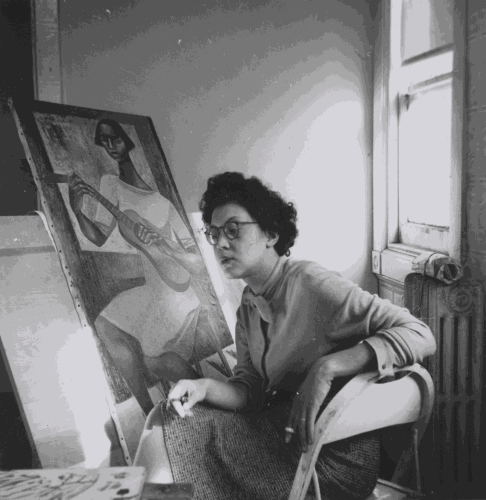Elizabeth Catlett is an artist most remembered for her abstracted sculptures of the human form. Influenced by studying with Grant Wood and Ossip Zadkine in the 1940’s, her naturalistic figurative sculpture and painting took on a modern style. Catlett’s combination of modernist influence, use of historic African American and Mexican artwork, and personal background synthesized a potent oeuvre and legacy.
With simple, clear shapes she evokes both the physical and spiritual essence of her subjects. Her hardy laborers and nurturing mothers radiate both power and a timeless dignity and calm. Whether working in wood, stone, bronze, or clay, Catlett reveals an extraordinary technical virtuosity, a natural ability to meld her curving female forms with the grain, color, or luster of her chosen medium. The beauty of her subjects is matched by the beauty she reveals in her materials.
After graduating cum laude from Howard University in 1935, she taught high school in Durham, North Carolina. Howard hadn’t been her first choice. She had a scholarship to the Carnegie Institute of Technology, in Pittsburgh, but the college refused her admission when it learned she was black. Catlett’s work is concerned with the racial biases and prejudices she encountered during her lifetime first hand. Catlett was a studio teacher at various institutions over the years which allowed her to maintain a full time studio practice. In 2008, the current Carnegie University president learned of her being discriminated against. He granted her an honorary doctorate as well as a one woman exhibition on campus at The Regina Gouger Millery Gallery.
A pivotal moment for Catlett occurred in 1946 when she accepted a grant from the Rosenwald Foundation to move to Mexico City to study printmaking. There she joined the Taller de Gráfica Popular, an influential and political group of printmakers. “I learned how you use your art for the service of people, struggling people, to whom only realism is meaningful,” she later said of this period. At this time Catlett was protesting, picketing, and even was arrested in her quest to win justice for those she describes as "my people." Moving from the United States to Mexico in 1946, she was eventually identified as an "undesirable alien" by the U.S. State Department for her political actions and became a Mexican citizen.
Catlett taught at the National School of Fine Arts in Mexico City from 1958 until her retirement in 1976, producing realistic and highly stylized two- and three-dimensional figures. She to created lithographs, linoleum cuts, and sculpture in wood, stone, clay, and bronze. She drew subjects from African American and later Mexican life. Catlett’s work captured the unique strength and endurance of women, while helping to explain through her art the issues of social, cultural, and political oppression, employing simple clear lines. Charlotte Streifer Rubenstein, author of American Women Artists has written that Alice Elizabeth Catlett is “considered by many to be the greatest American black sculptor”.
